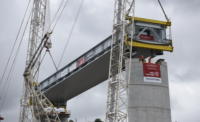From brick-and-mortar construction projects to providing school meals, U.K. contractor Carillion PLC was a major government supplier before spiraling debt forced it into bankruptcy on Jan. 15. While thousands of workers and hundreds of subcontractors and suppliers wonder about their futures, the firm’s parlous performance has raised a storm over public outsourcing.
“It is time to put an end to the rip-off privatization policies that have done serious damage to our public services and fleeced the public of billions of pounds,” said Jeremy Corbyn, leader of the Labour Party, the government’s main opposition. “This is a watershed moment.”
Having issued three profits warnings since last July, Carillion failed to secure funding from its creditors, as its debt ballooned to an estimated $1.8 billion. With sales of about $7 billion a year and forecast losses exceeding $1.4 billion, the firm had become virtually worthless.
As Carillion fought for survival, the firm shed CEO Richard Howson and the senior management of the construction and services divisions. Howson’s replacement, Andrew Davies, was due to take over Carillion this January.
With nearly 40% of Carillion sales coming from public contracts, the government ensured funding of current projects from the date of the collapse, securing an estimated 11,000 jobs. “But what about Carillion’s 8,500 private-sector workers?” asked Tim Roache, general secretary of the GMB general workers union.
And because Carillion reportedly withheld subcontractors’ pay for 120 days, many small firms are in peril. Carillion owes subcontractors $1.1 billion, according to the Building Engineering Services Association. To help these firms, three major banks launched funds totaling $310 million.
Despite profit warnings, Carillion continued to win public contracts, recently including a four-year framework for substantial schools building and two large deals for state-owned Network Rail. At the time, interim CEO Keith Cochrane noted that the railroad awards showed “that we continue to have the support of key customers.”
Asked in Parliament why the government had awarded Carillion more than $2.8 billion in contracts since the first profit warning, Prime Minister Theresa May said, “If the government pulled out of contracts … whenever a profit warning was issued, that would be the best way to ensure that companies failed.” All but one of the new contracts awarded were to joint ventures, she added.
In the same month as its first profit warning, Carillion, in a joint venture with Kier Group PLC and Paris-based Eiffage Group, on July 20 secured two design-build contracts, totaling $1.5 billion, from the government’s HS2 Ltd. That job involves some 80 kilometers of the new London-Birmingham high-speed railroad.
After Carillion’s collapse, “we wrote to Eiffage and Kier to remind them of the conditions they [had] bid on,” says a spokesman for the owner. Within days, Kier and Eiffage took over Carillion’s role on the contracts. Kier also displaced Carillion in a highway-project joint venture.
Farther north, work effectively halted at Liverpool’s nearly complete Royal hospital, being built under a 30-year public-private partnership. The owning trust is waiting for Carillion’s partners to resume construction on the 646-bed unit, says a spokesman.
Equity Stakes
Carillion and financial investors have equity stakes in the Hospital Co., Liverpool, which sealed a design, build, finance and operate contract with the trust in December 2013. Carillion has a $464-million construction contract with the Hospital Co. and another for facilities management.
The Liverpool project is one of more than 60 P3s with Carillion involvement. Having grown since the 1990s from the merger of several medium-size contractors, the group expanded into operations-and-maintenance services. Its forebears were among the first to bid when the government began using P3s in the early 1990s.
The pace of P3 procurement has slowed since the banking crisis, but U.K. public bodies already pay annual fees for such projects totaling $14.3 billion, with the public health sector accounting for 20%, according to a new report by the National Audit Office.
By the time the latest of the more than 700 contracts ends in the 2040s, total payments will amount to $276 billion.
Since P3 financing is more costly than public borrowing, P3s must demonstrate other gains over standard procurement, claims the government. NAO notes, however, that “we have been unable to identify a robust evaluation of the actual performance of private finance at a project or program level.”
Opposition to P3s and other forms of public-service outsourcing has intensified with the Carillion crash. “No longer can the labyrinthine structure of contracting and subcontracting be regarded as a suitable foundation on which to rest our public services,” claims Len McCluskey, head of Unite, the country’s biggest trade union.
While conceding that P3s have their failings, Tony Travers, professor in the department of government at the London School of Economics, thinks they have benefits, too. “We need to pause and think about the right way forward,” he says.






Post a comment to this article
Report Abusive Comment